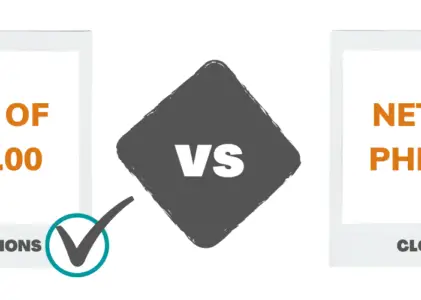Knowing when to close a business isn’t just about avoiding losses. There are valid financial reasons to continue operating despite not making a profit, but the concept is buried in complex economic theory. I find that unfortunate given its broad application to small business owners. And it doesn’t have to be complex either. So, speaking in ordinary English, how do you know when to close down a business vs. when to continue to operate even when incurring losses?
When incurring losses, you have three options to choose from: (1) Continue operating at a loss, (2) temporarily shut down operations, or (3) permanently close operations.
A business should continue operating at a loss when every unit sold decreases the total losses incurred. By contrast, it’s better for the business to temporarily shut down when the incremental sales only add to the losses but long-run prospects look promising. And if profitability isn’t expected to improve in the future, then a business should permanently close.
This post discusses these points in detail.
Page Contents
What this post is not about
There are non-economic considerations to close a business, such as deteriorating health or passion. There are also reasons to close a profitable business. Both aren’t tackled here.
Instead, we’ll talk about the 3 potential options mentioned in the intro.
Economics reasons to operate when incurring losses
What are the reasons firms continue to operate even when incurring losses?
A business may continue to operate, despite incurring losses, if management is optimistic about its future and the current sales continue to lessen its losses.
This is part of the message of the shutdown decision in economic theory, explained thoroughly by Khan Academy in this video:
(This is assuming a single company’s independent decision rather than a portfolio of business segments. There are occasional tax advantages in offsetting gains of another business.)
Fair warning, the lecture uses a lot of jargon. So rather than abstract economic concepts, let’s take an example.
Continue to operate (example)
Suppose your food stall sells rice bowls for Php100.00 each (around $2.00). Let’s also assume the average variable cost is Php70.00 ($1.40) per rice bowl. That means every rice bowl sold contributes Php30.00 ($0.60) to your business.
(Remember: You effectively get Php30.00 for every sale, not Php100.00, because you incur Php70.00 in raw materials, cups, etc., every time you sell a rice bowl.)
Let’s also assume the total rent (and other short-run fixed costs) are Php20,000.00 ($400.00) per month.
(Short-run fixed costs are costs you can’t change now. In the long-run, you probably can cancel your rental agreement with the landlord.)
If the number of rice bowls sold was 500 cups, then the net loss for the month was Php5,000 ($100):
CONTINUE OPERATIONS
Sales = Php100.00 x 500 = Php50,000.00 ($1,000.00)
Total Variable Costs = Php70.00 x 500 = Php35,000.00 ($700.00)
Total Fixed Costs = Php20,000.00 ($400.00)
Net Loss = Php50,000.00 - Php35,000.00 - Php20,000
Net Loss = -Php5,000 (-$100.00) If instead, the business opted to temporarily close, then the net loss would’ve been larger due to the fixed costs you’d need to pay anyway.
CLOSE OPERATIONS
Sales = 0
Total Variable Costs = 0
Total Fixed Costs = Php20,000 ($400.00)
Net Loss = 0 - 0 - Php20,000
Net Loss = -Php20,000 (-$400)In this example, operating at a loss would’ve been better for the business due to the rent (and other short-run fixed costs) you would’ve incurred regardless.

The decision to shut down or operate is closely tied to these 3 topics:
- When Selling Less Earns Your More: Profit Maximization
- Does Lowering Prices Increase Sales? 2 Ways Math Says Yes and No
- 3 Easy Steps to Know if a Business Idea is Worth Pursuing: Breakeven Point
Temporary shut down of operations
In the previous example, the major takeaway was to continue operating at a loss if the revenues you get per sale are more than the additional costs incurred per sale. Specifically, average variable costs are too high to cover.
In contrast, the business should temporarily shut down operations if average variable costs are too high to justify operating now but management expects profitability to improve in the future.
Pause in operations during COVID (example)
When do you temporarily close a business due to COVID or some other reason? It is at a point where variable costs become too high and/or quantity sold is too low. Let’s reconsider the average variable formula.

Average variable cost is computed as the total variable costs incurred in a month divided by the quantity sold.
Two factors influence this number: (1) Variable costs and (2) quantity sold. This means for the same cost structures, the average variable cost can actually increase due to a decline in quantity sold. And that’s not considering some of the increases in costs due to, for instance, the logistical restrictions during COVID. Take for example our previous hypothetical food stall.
When a food stall operates, some variable costs remain approximately the same throughout the day (e.g., store lights, bulk deliveries, etc.). I’d like to think of these as binary costs (I made this up. It’s not officially an economic term) with on-and-off switches. You either incur them, when you open your store, or not.
With a slowdown in sales, the result is a high average variable cost that may be more than the revenue generated per sale.
In short, when the average variable cost is greater than the revenue earned per sale, every unit sold makes the business’s losses worse.
For some businesses, operating during COVID would’ve meant each sale worsened their profitability.
Today is June 4, 2021, and with the worst out of the way, people expect most businesses to bounce back. If this expectation is correct, then temporarily shutting down operations and opening again in the future, would’ve been the right choice.
(Note: In practice, average variable costs are measured after the fact. This makes it hard to decide then and there.)
Permanent closure of the business
How do you know, in the economic sense, when it’s time to close down a business?
If the business’s average variable cost for every unit sold is more than the revenue earned per sale (i.e., the condition for temporarily closing operations) and you don’t expect profitability to improve in the future, then it’s time to permanently close the business.
Conclusion
Knowing when to close a business is a difficult process, but these economic principles make the decision a bit easier. It’s still never going to be an easy decision, and there are non-economic factors to consider.
A lot of the deciding points here rely on projections and expectations. The average variable costs are known after the fact, and the decision to continue or close operations depends heavily on your expectation of future profitability.
To me though, the biggest takeaway is that a business can continue operating at a loss and be a step forward against closing altogether. It’ll have to be under the right conditions, but it is certainly not unusual.








